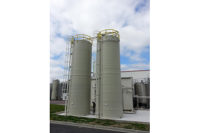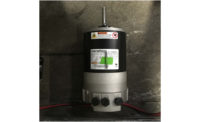Dairy producer reduces refrigeration energy use with Dyneo permanent magnet motors
Since refrigeration is a key element in the manufacturing process, optimum operation and reliability is paramount.

Inex, a Belgium-based producer of dairy products, achieved minimum energy savings of at least 18% from its refrigeration process as a result of switching to Dyneo permanent magnet motor technology from Emerson Industrial Automation USA LLC (formerly Control Techniques Americas LLC), Eden Prairie, Minn., and Leroy-Somer Motors & Drives, a St. Louis-based unit of Emerson Industrial Automation. The solution, which also features a Leroy-Somer Powerdrive high-power modular drive, is being used in an industrial refrigeration system that cools milk after pasteurization or sterilization.
Based near Ghent, Inex specializes in milk, chocolate milk, buttermilk, fermented milk, yogurt, cream and butter for large European retail chains and multinationals.
Since refrigeration is a key element in the manufacturing process, optimum operation and reliability is paramount. As part of a recent investment package, Inex acquired four new industrial refrigerator systems featuring Sabroe SMC 106E reciprocating ammonia compressors. At the time, Inex read reports of permanent magnet motors and wanted to install one as a trial. As a result, three of the compressors were supplied with standard Leroy-Somer IE2 (90kW) asynchronous AC motors, and one with a Leroy-Somer IE4 (105kW) synchronous permanent magnet motor from the Dyneo range.
The refrigeration systems are used to cool water to 1°C, which in turns cools milk to around 4°C. The installation operates almost continuously, but at variable load. Here, the benefits of permanent magnet motors come to the fore, as their performance retains almost constant partial load, unlike standard asynchronous motors, generally leading to a reduction in energy consumption.
To put the theory to the test, Control Techniques and Leroy-Somer’s experts visited Inex after the installation was complete. They discovered that the refrigerator operating with the Dyneo permanent magnet motor was delivering significant energy savings.
Using a digital energy analyzer, the drive and motor experts made a series of power measurements comparing two refrigeration units working at the same conditions. One featured the LSRPM280SC-T synchronous magnet motor (105kW) running at 1500 rpm and Leroy-Somer Powerdrive, while the other housed the standard LSES280MK-T (90kW) asynchronous motor running at 1487 rpm and a competitor drive.
The analyzer showed that energy savings were being achieved using the permanent magnet motor across a range of different load profiles. Depending on the type of measure – involving number of pistons, speed, evaporation temperature and condensation temperature – the calculated energy savings were between 18-21%, taking into account any losses from the drive and the motor.
Looking for a reprint of this article?
From high-res PDFs to custom plaques, order your copy today!





